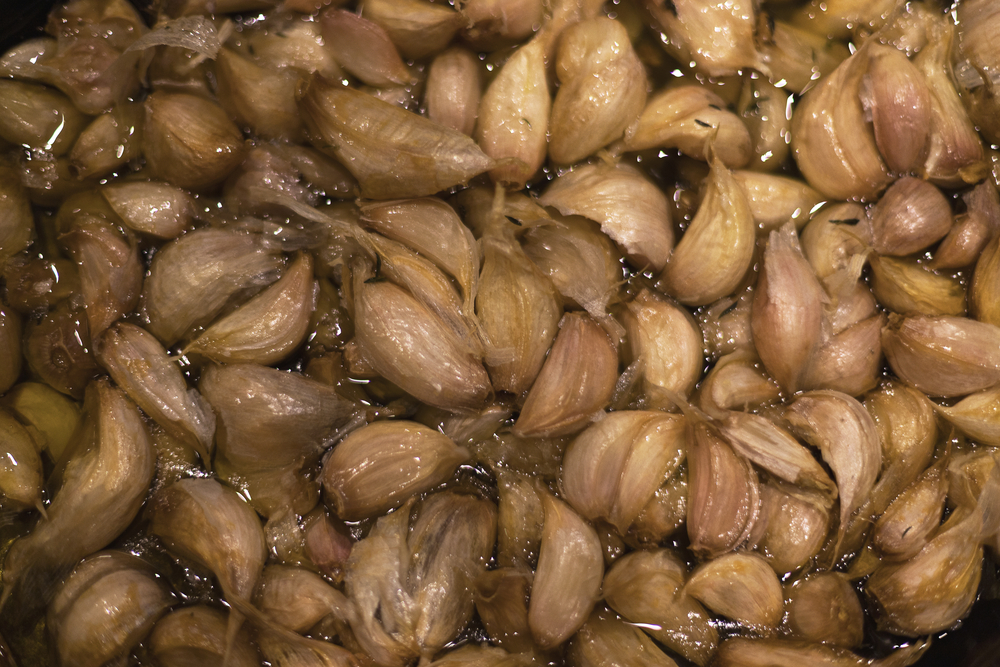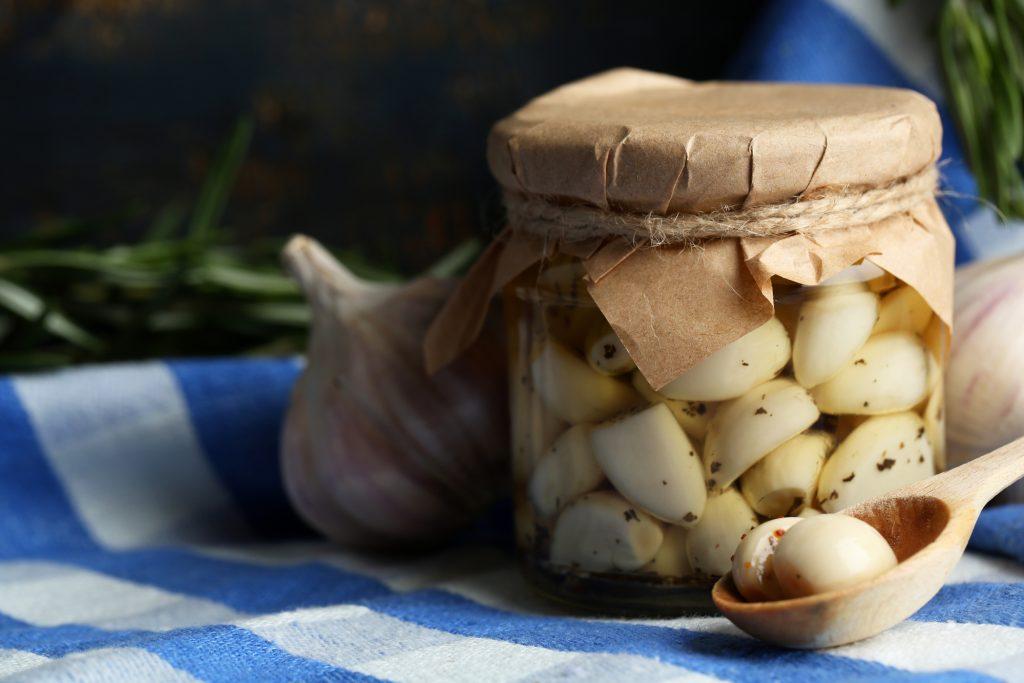Strong and pungent when raw, sweet and creamy when baked, and one of the best immune boosters. Garlic is one of the world’s best-known herbs, vegetables, and medicines.
Roast ribs, marrowy toast, spinach and sorrel, aioli, garlic butter, garlic bread and bread rolls, spaghetti aglio e olio, fish dishes, seafood, mushrooms – the list of dishes that would be unimaginable without garlic goes on and on. It is an antioxidant, antibacterial, blood pressure regulator, aphrodisiac, and immune booster, and wards off colds. Garlic (Allium sativum) is a bulbous plant of the lily family, native to Central Asia, and has been known worldwide for about 6,000 years. There are two varieties, the soft-stemmed (Allium sativum sativum) and the hard-stemmed (Allium sativum ophioscorodon), and about 600 subspecies are known.
In addition to its culinary values, it is used worldwide for medicinal purposes
The pharmaceutical industry is mainly interested in it for its antimicrobial properties, but it also has a significant blood thinning and cleansing effect. Its antibacterial active ingredients are alliin and allicin, and it also contains vitamins A, B, C, and E. Raw garlic is high in potassium, phosphorus, and calcium.
It was known and used by the ancient Egyptians, who not only buried their pharaohs but also strengthened their slaves with garlic. It was also used by the ancient Romans and Greeks, whether for sporting events or to fortify soldiers going to war. Over the centuries, it has been associated with both good and evil, with some superstitions believing it grew from the footprint of Satan leaving the Garden of Eden, while others see it as a protector, keeping evil at bay.
One of the best-known recipes for colds and a general immune booster is a little crushed garlic mixed with honey. It is also recommended as a remedy for sore throats, coughs, respiratory illnesses, and colds, but also as a preventative, with a small spoonful a day. Honey is not called a miracle cure for anything: it has been used for centuries for its antibacterial properties, which not only help with sore throats and colds, but it has also been used to heal wounds and, in addition to its antimicrobial properties, it has a beneficial effect on the digestive system, blood pressure, and heart function. That’s why it’s a good combination with garlic.
Bactericidal and antiviral
It has both bactericidal and antiviral effects, thanks to the allicin it contains: it is even more effective than penicillin against certain micro-organisms. It can also be used against pathogens that cause digestive disorders: garlic soup is an old home remedy for stomach and intestinal complaints. Its antibacterial properties have made it an important preservative for meat for centuries, for example, by preventing botulism, a serious food poisoning caused by bacteria. Its antiviral properties also make it useful against enteritis, hepatitis, and herpes. It also fights certain fungal infections, which is why garlic solutions are used to treat skin fungus.
Less well known, garlic is also a natural aphrodisiac. There are several reasons for this: in addition to its blood-purifying action, it has a significant tonic effect and stimulates the pituitary gland and the hormonal system. However, the effect is not immediate, and in fact, with a strong garlic smell, we often have to give up successful dates for a whole day.
Fermented honey garlic fits in perfectly with today’s gastronomic trends.”
An exciting variation on the garlic and honey duo, fermented garlic with honey is a perfect match for today’s gastronomic trends. Cut 10-15 cloves of clean, preferably organic (i.e. untreated) garlic in half or crush them with the blade of a knife and put them in a clean jar. Pour over about three decilitres of honey and stir well. Leave it in a sealed jar at room temperature for two or three days, during which time bubbles will form around the garlic and the water content of the cloves will dilute the honey. Then open, stir and repeat every two days. After a week it is ready to eat, but it will keep for up to two months at room temperature. Garlic can be eaten on its own with honey, but can also be used with meats, fish, and salads, and is also recommended drizzled over hot pizza, as a base for sauces, or simply spread on toast.
The longer you leave garlic honey to ferment, the darker the cloves become, the more liquid the honey becomes, and the more it can become quite foamy in the process. It is important not to overcrowd the jar, to leave room for the gases that are produced in the meantime, and not to put it in a sunny place.
What starts fermentation?
Honey has a basic bactericidal property, which is apparently the enemy of fermentation, as its low water content and acidity kill microbes. However, the water content of lightly crushed or even halved garlic seed kernels weakens this property of honey, giving room for various bacteria and yeasts to break down the fructose and glucose content of honey and garlic. This triggers fermentation, which results in an exciting flavor.
How do we store garlic?
It’s best to eat the tender spring garlic as soon as possible, while it still has a fresh, vibrant flavor. If stored correctly, white garlic will keep for almost six months, and pink garlic for up to a year. To do this, the cloves need to be relatively dry, which means hanging them in bundles or spreading them out on a wire rack in a dry, cool place or at a moderate temperature (max. 65 °F). In Arleux in France, the garlic is preserved in a very special way: the pink garlic is smoked with peat, which gives it a brownish hue and an exciting flavor. The hanging bunches are smoked for ten days, so they keep all year round.
Confit Garlic
Ingredients:
4 heads of garlic
3.5-4 dl olive oil
Preparation:
Separate the garlic cloves, but do not remove the skins. Place in a 20×20 cm baking dish, add the spices and pour in the olive oil, which should cover the cloves completely. Cover with foil and place in the oven, preheated to 255 °F, for 75 minutes. Check a clove: it is ready when it is soft and creamy when squeezed out of its skin. Leave to cool, then put in a tin or jar. It will keep in the fridge for two to three weeks. You can also make it on the stove by putting the garlic cloves in a small, high-walled saucepan, adding the spices and pouring in the oil. Start confit over a very low heat: do not boil, but make sure the oil is hot enough to form small bubbles around the cloves. The process can take up to two hours, checking for tenderness in the same way as if you were cooking in the oven.

How to eliminate the smell of garlic?
Many people swallow garlic chopped up as a medicine so that it stays in the mouth as short as possible and leaves no smell behind. Neutralizing effects are attributed to warm milk, honey, red wine, roasted coffee, and fresh parsley. The latter obviously also counteract the odorants of garlic with their own aroma, so that they tend to suppress it.
But the stubborn smell of garlic is not so easy to circumvent: the aromas are not only absorbed in the stomach but also pass from the intestines into the bloodstream and are distributed throughout the body. Some of them leave the body in the urine and some in the sweat, so our body odor will tell us what we have consumed.
Milk against garlic odor
All you need to do is sip a glass of milk with the raw garlic. It is important not only to drink the milk afterward, but also while you are eating the garlic because if the milk reacts with the allyl methyl sulfide compound in the mouth, it will neutralize its strong odor more effectively.
This pungent-tasting organic sulfur compound does not break down during digestion and is therefore excreted in breath and sweat – even the next day. Researchers say that it doesn’t matter what kind of milk you drink: high-fat versions are the ones that lose the garlic smell the most.
3 Dishes Guaranteed To Banish That Nasty Garlic Stink!
Garlic lovers can relax: finally, a cure for bad breath! A team of American scientists has studied the problem and found the solution.
Everybody loves garlic because it’s delicious and healthy – and everybody hates garlic because it makes your mouth stink so bad it makes your face melt. Now, a team of scientists has helped enormously in solving the eat-or-die dilemma, as they’ve carried out a study to find out how to effectively get rid of the garbage dump in our mouths that garlic toast for breakfast can put there.
Scientists from Ohio State University looked at which substances in garlic best help break down the components that cause bad breath – di-allyl disulfide, allyl mercaptan, allyl methyl disulfide, and allyl methyl sulfide.
In their experiments, each participant was given 3 grams of garlic, which they had to chew for 25 seconds and then rinse with a glass of water.
Subjects were then asked to eat raw, juiced, or heated apples, raw or heated lettuce, raw or juiced mint leaves, and green tea, followed by a breath test. The participants’ breath was analyzed by the researchers using a spectrometry device that detects traces of gases and their composition. The measurement was repeated up to one hour after consumption.
Unsurprisingly, after inhaling, the scientists found that mint leaves led the way in deodorizing, but raw apples and lettuce also did very well in the test. The latter reduced garlic odor-forming compounds in the mouth by 50% or more in the first half hour after consumption. Mint had an even stronger anti-inflammatory effect, but neither the squeezed nor the heated versions had any real effect. And green tea did not work at all.
Raw apples, lettuce, and mint leaves performed so well in the test because, in addition to odor-busting enzymes, they also contain phenolic compounds that destroy garlic volatiles.
How to get the garlic smell off your hands
What can you do to make the terrible smell go away? Wash with soap? It doesn’t work. Lemon juice, vinegar rub? Nothing.
Here’s a trick to get rid of the smell.
What you need
- Soap
- Water
- Anything made of stainless steel (spoon, tap, dog bowl, etc.)
What to do:
- Soap your hands.
- Using a stainless steel tool, gently rub and erase your hands (palms and back of your hands) until they are odorless.
- Rinse with water.
Why it works?
Simple chemistry! The sulfur molecules in garlic are bound by the steel, attracting the odor.
Last updated: September 24, 2023



Comments are closed.